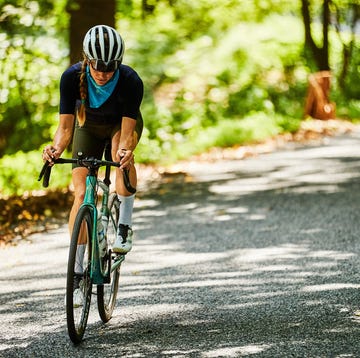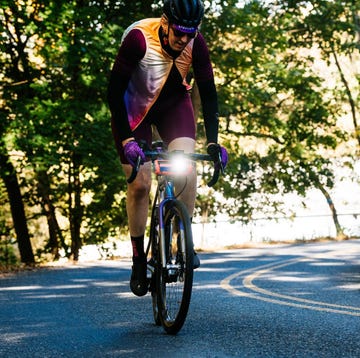Gravel biking is a sport of extremes. In my experience of riding and racing gravel since 2011, I’ve pretty much seen it all. You can find yourself alternately whizzing blissfully along quiet dirt roads under puffy clouds dotting a pale cotton candy sky, and navigating an endless minefield of pointy, uneven rocks while the cruel, glaring sun threatens to flog you to a standstill.
That can be hard to prepare for, especially since gravel events also tend to be long. Most of the major players are in the 100-mile range; some, like Unbound Gravel and Coast to Coast are twice that distance. But even the shorter distances offered at these events are on terrain that makes them considerably more arduous than similar paved rides.
Join Bicycling All Access for more tips and tricks!
Some riders, especially if they’re coming from the road, underestimate the challenges that await these distances. Others get overwhelmed into a state of analysis paralysis. Success lies in that middle ground of being prepared “just right.”
Here are your top six essentials for nailing your first gravel century.
The right tire
In gravel, your bike is really just a support system for your tires, because tires are everything. There are many different options you can choose here, but, you can be successful by checking three boxes:
→ Tubes: First things first: no matter what size and tread you choose, go tubeless. The ability to run lower pressures will dramatically improve your ride experience. They’re also less likely to flat.
→ Size: If in doubt, choose 38 to 40s—it’s the go-to size for a lot of Unbound (formerly DK200) veterans. They roll efficiently on the smoother stuff and provide enough extra volume for cushion when the terrain gets chunky.
→ Tread: It’s hard to go wrong with a mixed-condition tire. They have a tightly spaced center tread to reduce rolling resistance on hard pack with enough grip to dig into softer surfaces and a pattern design that prevents them from getting packed up in sloppy sections. I’ve successfully raced Schwalbe G-One Allround tires across Michigan, at Unbound, and even at The Mid South in 2020 (when it was 100 miles of goopy, red clay).
More than enough hydration
Hydration is power … and survival. As a rule of thumb, unless the rider’s guide explicitly assures you that you’ll have ample opportunities to top off out on course, carry one more bottle than you think you need—generally three, rather than two, will do.
Pro tip: Along with your sports drink of choice, carry one bottle of plain water to help chase down all the carbs and avoid palate fatigue.
Many gravel bikes have the capacity to carry two bottles in the main triangle and one underneath the top tube, or even on the fork legs. If your frame doesn’t accommodate three bottles, consider other easy options:
→ Stem bag: Bike bag companies make stem bags that hook onto your handlebar and stem and hold third bottle in an easy-to-access, yet out-of-the-way spot.
→ Hip pack: Hip packs such as Bontrager’s Rapid Pack make carrying a third bottle—and some extra stuff—a breeze.
→ Hydration vest: For very long events, especially once you hit 200 milers, a pack such a Camelbak Chase Bike Vest is a great option, because it lets you carry fluids comfortably, while also having full access to your pockets.
Note: You can opt for a rear bottle mount, which attaches to your saddle. Just be sure to do a test run with this set up before taking it to the races. Many of these eject bottles pretty easily, which is dangerous for those around you and leave you without a bottle.
Sufficient fuel
Long gravel rides are often called “eating and drinking contests,” because you need a lot of fluids and fuel to get through them. Gravel nutrition is hard to perfect, even for experienced riders.
Riders often stash some food in their pockets and/or bike bags, and plan to just eat when they’re hungry. For moderate rides, you can get away with that, but that won’t fly for a gravel century. Even if you’re pacing yourself properly, gravel riding uses more energy than road cycling, because of the terrain. In fact, research shows that a rider’s heart rate is about 7 percent higher and they’re using nearly 3 percent more oxygen riding with road vibration that is present during gravel rides than without road vibration.
That means you can be maintaining a mostly aerobic effort, but because you’re pushing harder, you’re whittling away at your glycogen stores without noticing … until the wall comes. Avoid the wall by nibbling away at your fuel from start to finish, aiming for about 200 calories an hour.
If you use a device that tells you how many calories you burn an hour, aim to replace about a third of what you’re burning. Bring a variety of foods, including some savory snacks. Your belly will grow weary of the sugar, and you’ll welcome some salt.
An endurance mindset
I was once coaching a rider who was insistent on basing his gravel times on his road times. Based off an estimated pace of 15 mph, he figured he could finish Unbound 200 in about 13 to 14 hours, including pit stops. I strenuously cautioned him to prepare to be out there much longer. It took him about three to four hours longer than his estimated time (there were also some prolonged food and rest breaks in there).
Gravel is just slower-going. If you’re accustomed to humming along at 15 to 16 mph on the road, expect to dial back that pace to about 12 to 14 on the gravel, depending on the road surface. Some courses roll fast; others, especially if there’s lots of mud, loose gravel, sand, stutterbumps, and even singletrack, will be slower going. Mechanicals happen. Things go wrong. Time passes. Plan your food, fluid, energy output, and dinner plans accordingly. For really big days, packing extra layers and maybe even bike lights can be a real ride-saver.
Sensible shoes
To be clear, you 100% can ride gravel in any cycling shoes. But once you start hitting triple-digit mileage, gravel-friendly shoes can make a big difference. Even if your feet never give you a moment’s trouble, those tired dogs can start to bark after five or six hours on stuttery terrain.
Road shoes generally prioritize stiffness, which is great for speed, but does nothing to dampen vibrations. Mountain shoes are armored to protect your upper foot, which can be overkill (and heavy) on a long gravel course. Gravel shoes like the Shimano RX8 or Giro Privateer, are stiff enough for efficiency, yet have some give for all-day comfort.
A desire for adventure
The most recent gravel event I raced—Rothrock GRIT in central Pennsylvania—finished up with a section of flowy singletrack punctuated by a fairly deep stream crossing.
At one point, as my little group was dismounting to wade across, someone behind us started grousing, “What’s this bullshit?” He was genuinely angry he had to walk through the water and get his feet wet. Don’t be that guy.
When it comes to gravel, you want to bring an attitude ready for adventure. Be prepared for cratered out roads, tire-swallowing sand, rocks, snow, puddles, streams, peanut butter-like mud, washboards, ruts, pea gravel, rock gardens, and every surface under the sun. The adventure is the appeal. When you expect it and are prepared for it, you’ll enjoy it. And that’s what it’s all about.















